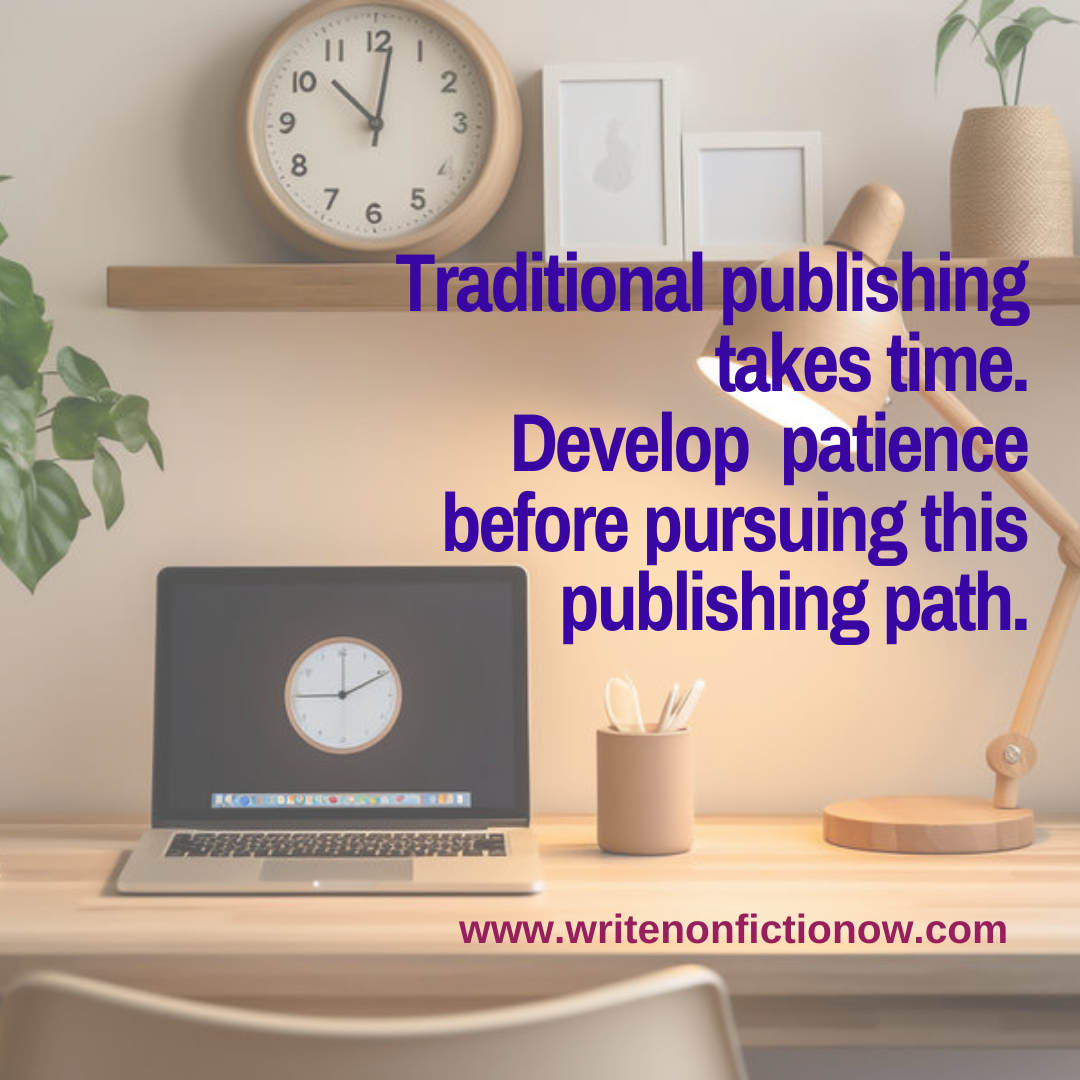Thursday, October 2, 2025

Patience is not just a virtue but a necessity for nonfiction writers who want to pursue traditional publishing. This publishing route is fraught with gatekeepers, delays, lengthy waiting periods, and extensions caused by the schedules of others. These things can test the resolve of even the most determined and tenacious writers.
Patience is considered a personal quality, trait, or characteristic. It’s the capacity to endure delay or difficulty without becoming upset or irritated. Patience can be viewed as a virtue that is both innate and developed through practice and experience.
You Need Patience from the Get-Go
Nonfiction writers need patience from the get-go. You don’t need to wait to start writing your book. And you don’t necessarily need to wait until your manuscript is complete to pursue traditional publishing. However, you do need to complete other tasks that can prove time-consuming and might mean patiently waiting before finishing your manuscript.
For instance, in most cases, you will need a literary agent to land a traditional publishing deal. To secure literary representation, you need to write a query letter and prepare a nonfiction book proposal.
These two documents can take several months, if not longer, to complete. Some writers complete the first draft of their book before starting on the query and book proposal. Most put all but their sample chapters on hold until they have perfected the query and proposal and begun sending them out.
Finding an Agent or Publisher
At this point, your patience is put to the test. First, you must identify literary agents (or publishers who accept unagented submissions) who specialize in your genre. Then you send a query letter to them asking if they are interested in your book project.
Receiving a response from agents or publishers can take months. I’ve known agents who replied to a query six months after it was sent. By that time, the writer had secured representation. In some cases, you receive no response, which means the answer to your query was “no.” ?Once you secure representation, your agent may request additional proposal revisions before submitting to publishers. This extends the overall timeline.
Since you are likely not the agent’s only client, you might have to wait your turn as well. And agents are people; they get sick, go on vacation, have family matters to attend to, and aren’t always as fast about getting things done as you’d like.
Publishers tend to respond more quickly to agents’ queries, rather than those of writers. Yet, even if they request to see your book proposal, the acquisitions editor interested in your project must wait for an opening in the editorial board’s schedule to pitch the book to the entire team.
Getting a final answer—yay or nay—can take months. And the acquisitions editor pitching your project may also ask for further proposal edits, take it to the editorial board a second (or third) time, and only then be able to provide a definitive answer.
If the answer is “no,” you begin the process again after your agent completes another round of query submissions. The same is true if you submit to publishers on your own.
The After-Acceptance Wait
Once your book proposal is accepted by a publisher, the negotiation period for the contract begins. Of course, you can simply sign and proceed. However, that’s not advised.
It’s best to read the contract carefully prior to signing. Your agent will also advise you on what, in their mind, needs to be changed before accepting the offer.
Even with an agent looking out for your interests, best practices involve hiring a literary or intellectual property attorney to review the document. Then, ask the publisher to make any suggested changes.
Negotiating a contract can be a time-consuming process that often involves multiple rounds of revisions, discussions, and legal review. Again, you’ll need to be patient as all the details are worked out between the parties involved.
Production Time Waiting
Once the contract has been signed, your manuscript enters the editing phase, which requires more patience. Editors may have other manuscripts in the queue, and yours might have to wait its turn. And editing can be a time-consuming process that takes weeks or months to complete.
The manuscript will be returned to you a few times for you to make or approve changes. You will go through this process with more than one type of editor, which means you will spend more time waiting for the green light to continue with the publishing process.
When that happens, your manuscript enters the design process. The cover may have been designed early on. Still, it needs approval from you and the entire publishing team, including the marketing department. The interior design also will require approval, which is a separate process.
Finally, the book will need to be proofed and indexed, all of which takes more time. Then, it gets printed and distributed to online and brick-and-mortar stores.
The Waiting Game
Traditional publishing truly is a waiting game. Consider one of my clients, a nonfiction writer passionate about environmental conservation.
After researching and writing his book for over a year, he spent another six months refining his proposal and query before beginning the submission process. Then he waited an additional eight months before securing a literary agent.
After final edits were completed on the proposal, another four months passed before the agent submitted the query to publishers. A few publishers requested the proposal, but it took a few more months to get an offer.
The publisher who acquired the manuscript assigned a publication date almost two years in the future.
How to Develop Patience
Not everyone is born patient. Some people need to develop this trait.
To develop patience, engage in personal growth, whether this means reading books about patience or hiring a Transformational or Certified High Performance Coach. Also, practice mindfulness and meditation, skills that help you stay present and allow you to focus on the current moment rather than all the things that are not happening fast enough for your liking.
Also, identify your impatience triggers, and accept what you can’t control. Triggers are the things or situations that cause you to get agitated about slow progress. If you can’t control or speed them up, why bother getting upset, right?
Cultivating empathy also can prove helpful. When you understand why things are moving slowly, you can more easily accept them.
Also, slow down during everyday activities to build tolerance for a less-quick pace. And use tools, like deep breathing or distraction, when you feel frustrated. You can also exercise, dance, or go for a walk, which helps calm your autonomic nervous system and subsequently reduces stress and agitation.
Be kind to yourself. Developing patience is a process requiring self-compassion.
Productive Things to Do While You Wait
When waiting feels difficult, engage in tasks and activities that benefit you and your book in the long term.
For instance, one of my clients used waiting periods to maintain her blog by sharing snippets of her publishing journey. She shared these on social media sites to drive traffic to her website, where she encouraged people to subscribe to her mailing list. (The additional subscribers increased the size of her author platform.)
She also wrote articles for publications related to the topic of her book. This activity helped her establish expert status and a presence with her audience.
By the time her book was published, she had built a robust platform of followers eagerly awaiting her book. She also turned frustrating wait times into key aspects of her successful book launch.
Keep Your Eye on the Prize
Traditional publishing is known for its lengthy process. Rather than seeing the waiting as a waste of valuable time, see it as an opportunity to cultivate patience, resilience, and personal growth. Use the time to build your platform, so you have an audience eager to purchase your book when it is finally released.
And keep your eye on the prize, which is achieving your goal of becoming a traditionally published author. With this status comes the reward of seeing your book for sale on bookstore shelves and in readers’ hands. That’s worth waiting for, is it not?
Do you believe pursuing traditional publishing will be tough because you don’t have enough patience? Tell me why in a comment below. And, please share this post with a writer who might benefit from reading it.

Would you like to write and publish nonfiction work, like articles, blog posts, books, or reports…and become a successful (and productive) author? Join the Nonfiction Writers’ University. Get the basic education you need and author and personal growth coaching to help you succeed as a nonfiction writer.
Enjoy a 30-day trial membership for only $1. If you’ve felt the desire to get coached and be supported as you pursue authorship, this program is for you. Participate in monthly group Author Coaching sessions and gain access to an extensive archive of writing and publishing resources.
Image courtesy of austler.
Nina Amir, the bestselling author of How to Blog a Book and The Author Training Manual, is a speaker, a blogger, and an author, book, blog-to-book, and high-performance coach. Known as the Inspiration to Creation Coach, she helps creative people combine their passion and purpose so they move from idea to inspired action and positively and meaningfully impact the world as writers, bloggers, authorpreneurs, and blogpreneurs. Some of Nina’s clients have sold 300,000+ copies of their books, landed deals with major publishing houses and created thriving businesses around their books. She is the founder of National Nonfiction Writing Month, National Book Blogging Month, and the Nonfiction Writers’ University. As a hybrid author she has published 19 books and had as many as four books on the Amazon Top 100 list at the same time. Her most recent book is called Creative Visualization for Writers, and tomorrow her 19th book will be released, The Write Nonfiction NOW! Guide to Creativity and Flow. Find all her books at booksbyninaamir.com or find out more about her at ninaamir.com.